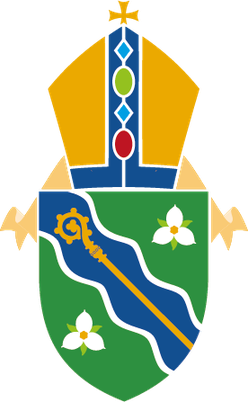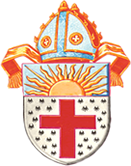The Anglican Diocese of Eastern Newfoundland and Labrador is one of seven dioceses of the Ecclesiastical Province of Canada in the Anglican Church of Canada. As of 2012 the diocese had 50,000 members in 81 congregations organised in 35 parishes. The most widely spread parish has thirteen congregations.
The Anglican Diocese of Western Newfoundland is a diocese of the Ecclesiastical Province of Canada of the Anglican Church of Canada. It comprises 77 congregations grouped in 30 parishes in Western Newfoundland, with approximately 17,888 souls. Most parishes are multipoint - with more than two congregations - with only one full-time clergy. As of 2012, the diocese had 20 full-time and over 350 lay ministers. As of 2019, this Diocese allows clergy to officiate same-sex marriages.

The Diocese of Niagara is one of thirty regional divisions in the Anglican Church of Canada. The see city of the diocese is Hamilton, with the bishop's cathedra located at Christ's Church Cathedral on James Street North. Located within the ecclesiastical province of Ontario, it borders the Dioceses of Huron and Toronto. The area enclosed by the Diocese of Niagara includes much of the Golden Horseshoe, and moves north to include Erin and Orangeville as far as Shelburne. Moving sharply south, the boundary includes Mount Forest and widens, south-westerly to include Elora and Guelph. Skirting Brantford and the Territory of the Six Nations Confederacy, the line then travels, again, south-westerly to Jarvis and Lake Erie to include the entire Niagara Peninsula. Major urban centres within its borders are St. Catharines, Niagara Falls, Hamilton, Guelph, Oakville, Milton, Burlington, and Orangeville.

The Diocese of Qu'Appelle in the Anglican Church of Canada lies in the southern third of the civil province of Saskatchewan and contains within its geographical boundaries some 50 per cent of the province's population of one million.

The Diocese of British Columbia, also known as the Anglican Diocese of Islands and Inlets, is a diocese of the Ecclesiastical Province of British Columbia and Yukon of the Anglican Church of Canada.

The Diocese of Montreal is a diocese of the Ecclesiastical Province of Canada of the Anglican Church of Canada, in turn a province of the Anglican Communion. The diocese comprises the 21,400 square kilometres (8,300 sq mi) encompassing the City and Island of Montreal, the Laurentians, the South Shore opposite Montreal, and part of the Eastern Townships. The See city is Montreal, and the cathedral is Christ Church. The diocese maintains approximately 9,000 on its parish rolls in about seventy parishes.
The Diocese of Edmonton is a diocese of the Ecclesiastical Province of Rupert's Land of the Anglican Church of Canada. The diocese comprises over 126,000 square kilometres of the civil Province of Alberta, consisting of a band across the central part of the province, extending to the borders of the adjacent provinces of British Columbia to the west and Saskatchewan to the east. Its See city is Edmonton, and its roughly 7,000 Anglicans on parish rolls are served by 53 parishes, according to the most recent figures published by the Anglican Church of Canada.

The Diocese of The Arctic is a diocese of the Ecclesiastical Province of Rupert's Land of the Anglican Church of Canada. It is by far the largest of the thirty dioceses in Canada, comprising almost 4,000,000 km2 (1,500,000 sq mi), or one-third the land mass of the country. As the name indicates, the diocese encompasses the Arctic region of Canada including the entirety of the Northwest Territories, Nunavut, and the Nunavik region of northern Quebec. The see city is Iqaluit, Nunavut, and the diocese's nearly 34,000 Anglicans are served by 48 parishes. The administrative offices of the diocese are located in Yellowknife, Northwest Territories.

The Diocese of Rupert's Land is a diocese of the Ecclesiastical Province of Rupert's Land of the Anglican Church of Canada. It is named for the historical British North American territory of Rupert's Land, which was contained within the original diocesan boundaries.
The Diocese of Algoma is a diocese of the Ecclesiastical Province of Ontario of the Anglican Church of Canada. It comprises nearly 182,000 square kilometres of the Ontario districts of Algoma, Thunder Bay, Sudbury, Manitoulin, and parts of the districts of Nipissing and Timiskaming. The diocese forms a wide band stretching from just west of Thunder Bay on the northern shore of Lake Superior east to the border of Ontario and Quebec. Neighbouring Anglican dioceses are Rupert's Land to the west, Moosonee to the north, Ottawa to the east, and Ontario, Toronto, Huron to the south.
The Diocese of Moosonee is a diocese of the Ecclesiastical Province of Ontario of the Anglican Church of Canada. It was created in 1872 from part of the Diocese of Rupert's Land, in what is now the Province of Rupert's Land, and transferred in 1912 to the new Province of Ontario. Now headquartered in Timmins, Ontario, it was originally headquartered in Moose Factory. Its first bishop was John Horden.

The Anglican Diocese of Quebec was founded by Letters Patent in 1793 and is a part of the Ecclesiastical Province of Canada of the Anglican Church of Canada, in turn a province of the Anglican Communion. In 1842, her jurisdiction was described as "Canada East" or "Lower Canada". The diocese comprises 720,000 square kilometres and took its present shape in 1850 with the carving off of what is now the Diocese of Montreal. It includes a territory of west to east from Magog to the Gaspe and the Magdalen Islands, south to north from the United States border to Kawawachikamach and several communities along the Lower North Shore.
The Anglican Diocese of Athabasca is a diocese of the Ecclesiastical Province of Rupert's Land of the Anglican Church of Canada, in the northern half of the civil province of Alberta. It was created in 1874 by the division into four parts of the original Diocese of Rupert's Land. The Synod of the Diocese of Athabasca was organized in 1876. The diocese was then itself subdivided in 1892 to create the new dioceses of Selkirk and Mackenzie River and in 1933 to create the Diocese of The Arctic.
The Diocese of Ottawa is a diocese of the Ecclesiastical Province of Ontario of the Anglican Church of Canada, itself a province of the Anglican Communion, in Ottawa, Ontario, Canada. The diocese was established on April 7, 1896.
The Diocese of Saskatchewan is a diocese of the Ecclesiastical Province of Rupert's Land of the Anglican Church of Canada formed in 1874. Its headquarters are in Prince Albert, Saskatchewan. The Diocese of Saskatoon was split off from it in 1933.

The Diocese of Brandon is a diocese of the Ecclesiastical Province of Rupert's Land of the Anglican Church of Canada. It has an area of 170,000 square kilometres (65,000 sq mi). Its cathedral is St. Matthew's Cathedral in Brandon, which was established in 1952.
The Diocese of Kootenay is a diocese of the Ecclesiastical Province of British Columbia and the Yukon of the Anglican Church of Canada.
The Territory of the People is a "recognized territory [with] the status of a diocese" formed in 2002 out of the former Anglican Diocese of Cariboo, part of the Ecclesiastical Province of British Columbia and the Yukon of the Anglican Church of Canada.
The Indigenous Spiritual Ministry of Mishamikoweesh is a diocese of the Anglican Church of Canada. It was created on 1 June 2014 from the northern portion of the Diocese of Keewatin, and includes more than 25 First Nations communities in north-western Ontario and northern Manitoba.








